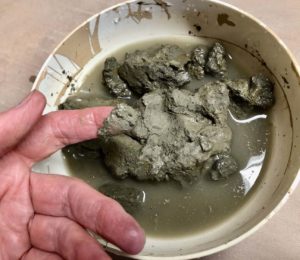I had an interesting email request the other day. Woojae Kim, a Vancouver resident who is currently a grad student at Bard College in NY state, asked me about finding local clay in Port Moody. Somehow he had found a blog which mentioned that I had found clay near our home in old Port Moody.
![]()
![]()
![]() Two stories here: In the first our house was very nearly engulfed by a mud-slide in December of 1979. After typical torrential rain the saturated fill (rocks and debris dumped in a back yard at the top of the Chines) slid downhill, along a clay-lined stream bed towards the houses on Hope street. Nobody died, but a house was buried. On subsequent walks up that creek we found the slippery clay deposit and I gathered a little, brought it home, and with the enthusiasm of a beginner potter, I threw a little pot with the un-sieved clay.
Two stories here: In the first our house was very nearly engulfed by a mud-slide in December of 1979. After typical torrential rain the saturated fill (rocks and debris dumped in a back yard at the top of the Chines) slid downhill, along a clay-lined stream bed towards the houses on Hope street. Nobody died, but a house was buried. On subsequent walks up that creek we found the slippery clay deposit and I gathered a little, brought it home, and with the enthusiasm of a beginner potter, I threw a little pot with the un-sieved clay.

In the second story, in the late 1990s, when I was a clay artist-in-residence at Port Moody Arts Centre (now PoMoArts) I mentioned to the drop-in enthusiasts that I’d spotted a large seam of the same blue-grey clay in the wall of a deep pit. It was being excavated to form the parking-lot level of Newport Medical building. We arranged for a city worker to take a load of it to the City Works Yard so that it could be used for clay experiments and I took a bucket home. I have no idea if the pile down by City Hall can still be found.. I doubt it.

![]()
![]()
![]()
![]()

 But after Woojae’s email I dug out some lumps of that old dry clay, added water, stirred it, sieved it and dried it a little so that I could show Woojae how it could be recycled. He was so interested to learn all about local clay and intends to use what he’s learned as part of his thesis dissertation. I mentioned that I had also taken some of the Port Moody clay slip and used it as a slip glaze on a cone 10 reduction-fired test pot. Now he wants to know all about the now-not-available Albany clay slip as his college is not far from that clay source. I gave him most of my bucket of that dry Newport clay, a lump of soft clay made from it, and a couple of ancient Chinese crocks that have been dug from local worker settlements of around 1900. I feel sure they are glazed, like the insides of Medalta sewer pipes, with slip clay glaze.
But after Woojae’s email I dug out some lumps of that old dry clay, added water, stirred it, sieved it and dried it a little so that I could show Woojae how it could be recycled. He was so interested to learn all about local clay and intends to use what he’s learned as part of his thesis dissertation. I mentioned that I had also taken some of the Port Moody clay slip and used it as a slip glaze on a cone 10 reduction-fired test pot. Now he wants to know all about the now-not-available Albany clay slip as his college is not far from that clay source. I gave him most of my bucket of that dry Newport clay, a lump of soft clay made from it, and a couple of ancient Chinese crocks that have been dug from local worker settlements of around 1900. I feel sure they are glazed, like the insides of Medalta sewer pipes, with slip clay glaze.

He had brought a bouquet of Spring flowers for me, so I feel that was a good exchange. On his next visit I think he’ll try to find that seam of clay that I mentioned in my first story, and I must take myself up there into the forest to make sure for myself that it can be found. Meanwhile I have another little lump of soft re-cycled Port Moody clay to, once again, make a little pot, and I plan to try out the slip on a cone 10 pot in the next high-fire soda firing. There’s alway stuff to learn or remember in the clay world.
![]()



Super cool! The clay we use with students comes via plainsman in Alberta but I love to tell kids about local clay and that there were brick factories around the lower mainland. Thanks for this info.
I’m so glad you found the information interesting. Thankyou for telling me. G